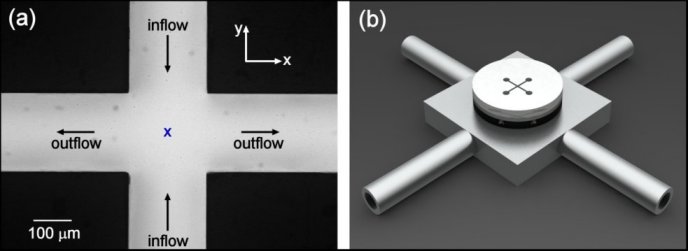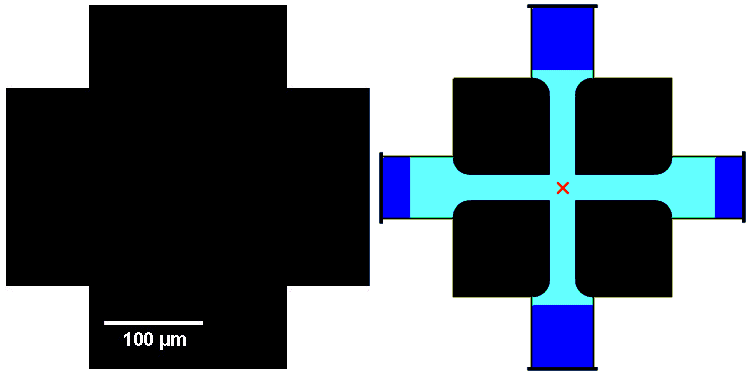Extensional
flows that involve stretching of
fluid elements arise in many natural and industrial processes,
including inkjet
printing, filament spinning, porous media flow, extrusion, moulding,
coating,
particle suspension/sedimentation, turbulent drag reduction, blood
circulation,
mucus flows (in e.g. lungs, eyes, mouth, etc) and the flow of synovial
fluid
between joints under compression. The fluids used in most of these
applications
are termed complex fluids or viscoelastic materials as their response
to
applied stress (or strain) involves a combination of solid-like
elasticity and
liquid-like ability to flow. For a fluid confined between two plates,
the
response to an applied stress (or strain) is measured typically using a
torsional
rheometer, where the shear viscosity describes the resistance offered
by the
fluid to a parallel displacement of the plates. In this case the
velocity
gradient is always perpendicular to the flow direction. If, on the
other hand,
the two plates are displaced so as to increase their separation, both
flow and
the velocity gradient are in the same direction resulting in a
stretching or
extensional flow field. Macromolecular stretching caused by the
exposure of complex
fluids containing long polymer molecules to extensional flow fields can
lead to
a much larger resistance to flow than expected on the basis of the
shear
viscosity measured in conventional torsional rheometers.
One of my main areas of inerest is the development of microfluidic extensional rheometry using the cross-slot geometry as a platform. Cross-slots consist of perpendicular bisecting channels with flow through opposing inlets and outlets. This generates a point of zero flow velocity (a stagnation point) at the centre of the cross, where macromolecules become subjected to a strong extensional flow. Macromolecular stretching can be observed by looking for flow-induced birefringence and near the stagnation point and results in an enhance pressure drop across the cross-slot, which can be used to assess the apparent extensional viscosity.
One of my main areas of inerest is the development of microfluidic extensional rheometry using the cross-slot geometry as a platform. Cross-slots consist of perpendicular bisecting channels with flow through opposing inlets and outlets. This generates a point of zero flow velocity (a stagnation point) at the centre of the cross, where macromolecules become subjected to a strong extensional flow. Macromolecular stretching can be observed by looking for flow-induced birefringence and near the stagnation point and results in an enhance pressure drop across the cross-slot, which can be used to assess the apparent extensional viscosity.

Flow
in the cross-slot can be driven continuously, or in an oscillatory
manner using piezo-electric micropumps on each arm of the cross. The
oscillatory flow is particularly useful for the study of biofluids or
in cases where the available volume of fluid is low. The system is
called the Extensional Flow Oscillatory Rheometer (EFOR) and the movie
below provides a schematic demonstration of how it works.

RELATED PUBLICATIONS
J. A. Odell and S. P. Carrington, Extensional flow oscillatory rheometry. Journal of Non-Newtonian Fluid Mechanics, 2006, 137, 110-120.
SJ Haward, JA Odell, Z Li and X-F Yuan, Extensional rheology of dilute polymer solutions in oscillatory cross-slot flow: the transient behaviour of birefringent strands. Rheologica Acta, 2010, 49, 633-645.
SJ Haward, Buckling instabilities in dilute polymer solution elastic strands. Rheologica Acta, 2010, 49, 1219-1225.
SJ Haward, JA Odell, M Berry, T Hall, Extensional rheology of human saliva. Rheologica Acta, 2011, in press, DOI: 10.1007/s00397-010-0494-1.
SJ Haward, V Sharma, JA Odell, An extensional opto-rheometer for biofluids and ultra-dilute polymer solutions. Soft Matter, 2011, in press, DOI:10.1039/C1SM05493G.
SJ Haward, TJ Ober, MSN Oliveira, MA Alves, GH McKinley, Extensional rheology and elastic instabilities of a wormlike micellar solution in a microfluidic cross-slot device. Soft Matter, 2011, in press, DOI:10.1039/C1SM06494K.